人教版(PEP)六年级上unit 4 I have a pen pal Part B
文档属性
| 名称 | 人教版(PEP)六年级上unit 4 I have a pen pal Part B | 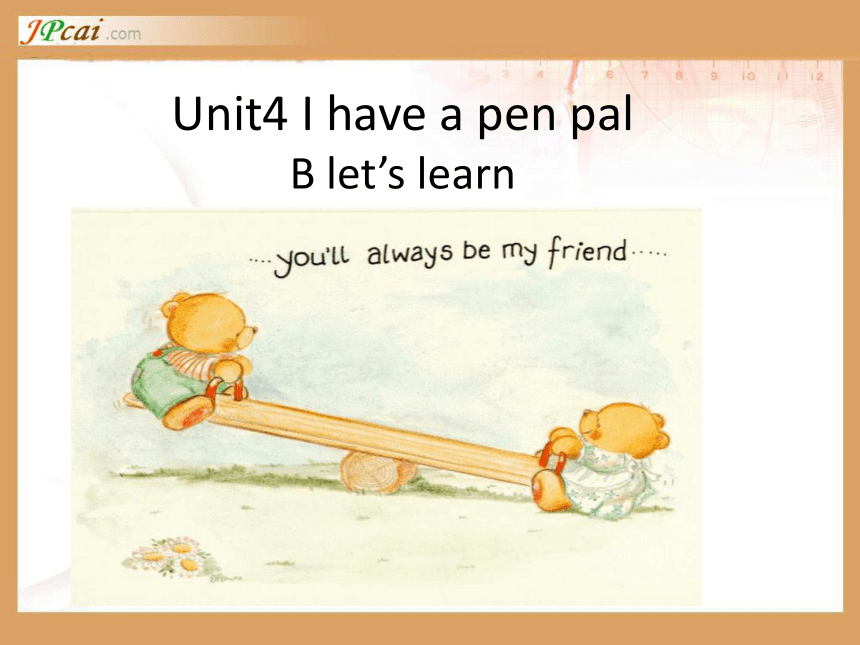 | |
| 格式 | rar | ||
| 文件大小 | 2.5MB | ||
| 资源类型 | 教案 | ||
| 版本资源 | 人教版(PEP) | ||
| 科目 | 英语 | ||
| 更新时间 | 2009-12-04 07:22:00 | ||
图片预览

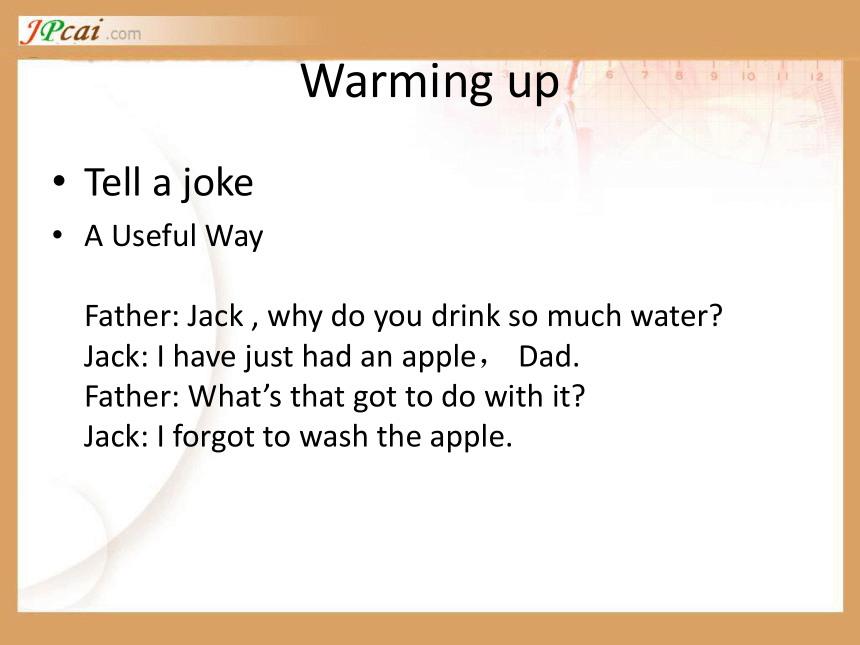
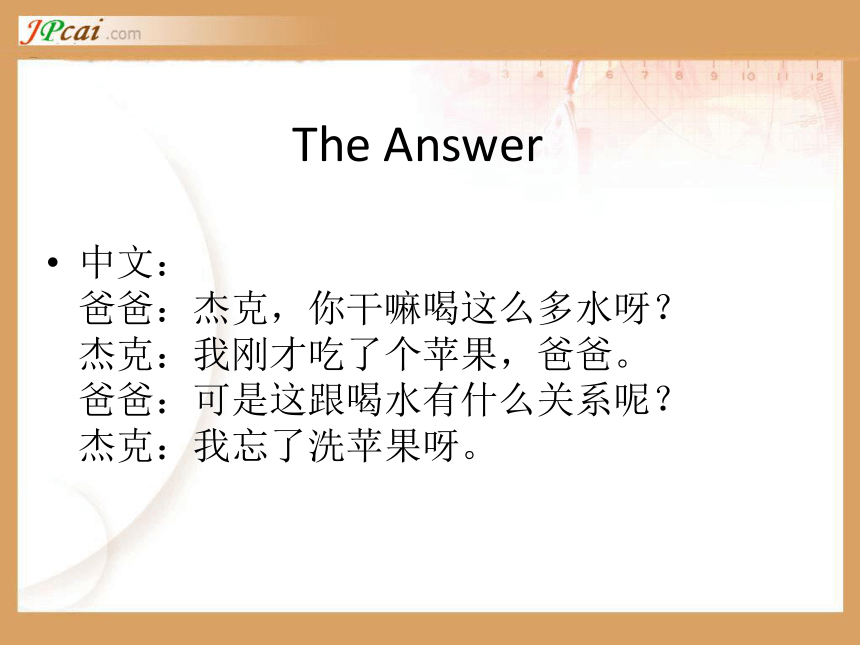
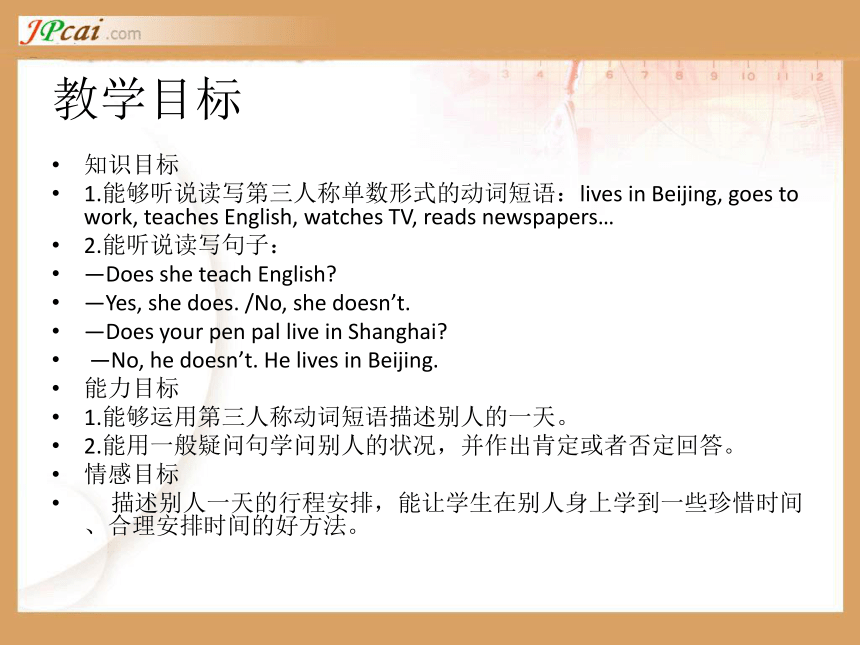
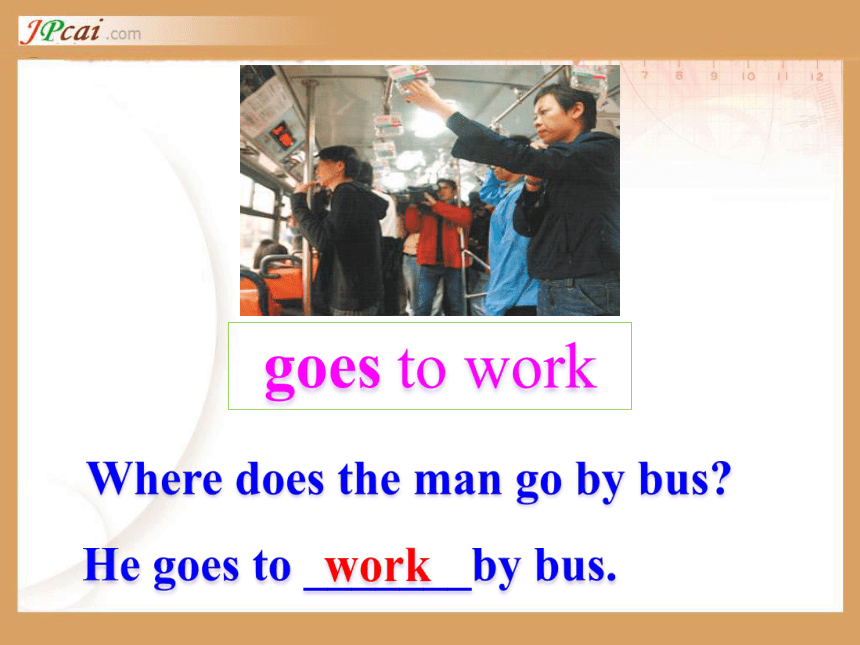
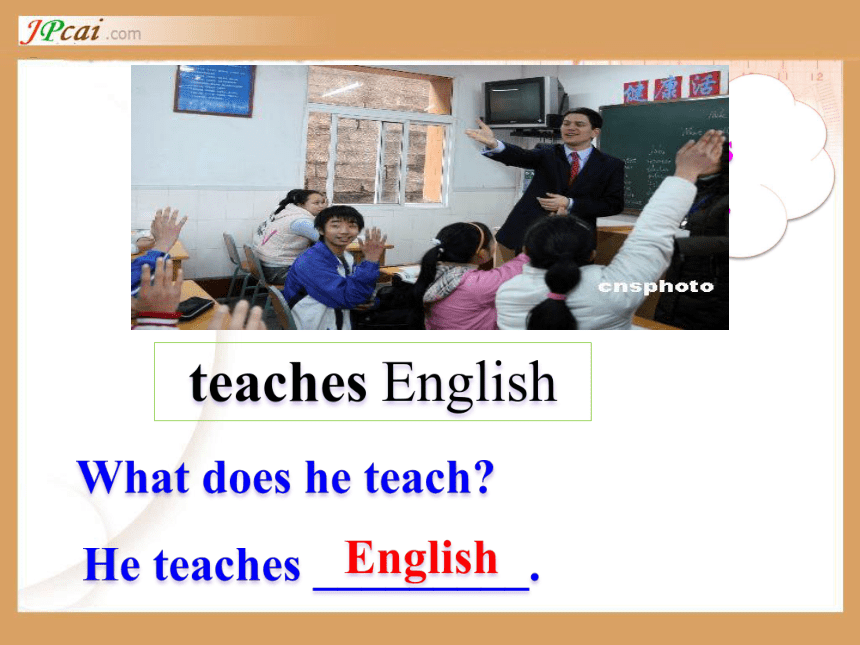
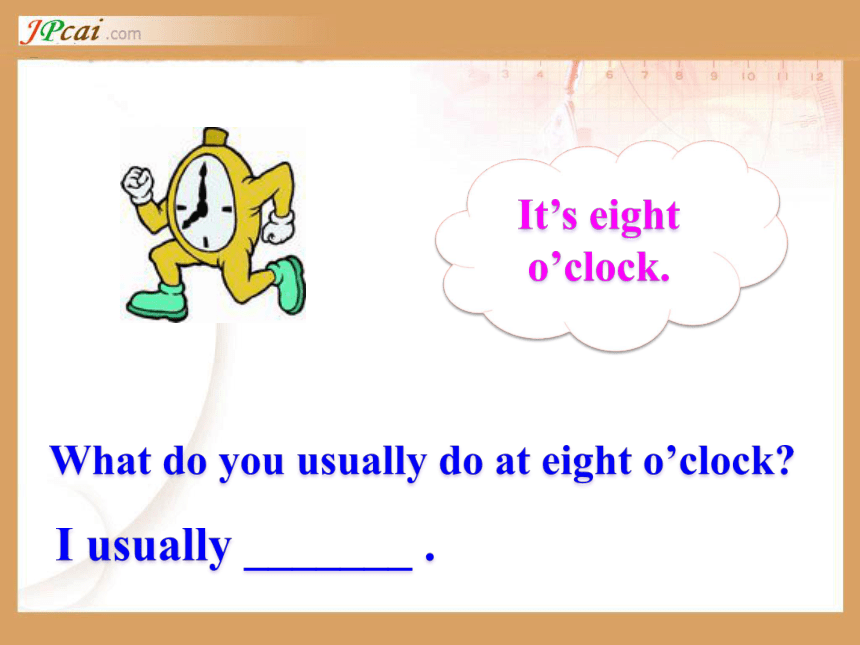


文档简介
课件27张PPT。Unit4 I have a pen pal
B let’s learnWarming up Tell a joke
A?Useful?Way Father:?Jack ,?why?do?you?drink?so?much?water?? Jack:?I?have?just?had?an?apple,?Dad.? Father:?What’s?that?got?to?do?with?it?? Jack:?I?forgot?to?wash?the?apple.? The Answer
中文: 爸爸:杰克,你干嘛喝这么多水呀? 杰克:我刚才吃了个苹果,爸爸。? 爸爸:可是这跟喝水有什么关系呢? 杰克:我忘了洗苹果呀。 教学目标知识目标
1.能够听说读写第三人称单数形式的动词短语:lives in Beijing, goes to work, teaches English, watches TV, reads newspapers…
2.能听说读写句子:
—Does she teach English?
—Yes, she does. /No, she doesn’t.
—Does your pen pal live in Shanghai?
—No, he doesn’t. He lives in Beijing.
能力目标
1.能够运用第三人称动词短语描述别人的一天。
2.能用一般疑问句学问别人的状况,并作出肯定或者否定回答。
情感目标
描述别人一天的行程安排,能让学生在别人身上学到一些珍惜时间、合理安排时间的好方法。
Where does the man go by bus?He goes to _______by bus.workgoes to workWhat does he teach?He teaches _________.Englishteaches EnglishHe works at school.What do you usually do at eight o’clock?I usually _______ .It’s eight o’clock.watches TVWhat does he usually do at 8 o’clock?He usually ____________.watches TVWhat does your father do every morning?He ________________.reads newspapersreads newspapersteaches English goes to work
by buswatches TV
at nightreads newspapers
every dayread –
look –
work –
say –
run –
go –
do –
watch –
teach –
have – 一般现在时动词第三人称单数的变化规则
1. 一般情况下,动词后直接加s.
Eg:works, gets, reads等.
2. 以s,x,ch,sh或o结尾的动词,在后面加es
Eg:goes, teaches, watches等。
动词have遇在主语是第三人称单数时,have改为has,如:He has an interesting book .
写出下列动词的第 三 人称单数形式
reads looks works saysrunsgoesdoeswatchesteacheshasLet’s practise My days
5:00 A.M get up7:00 eat breakfast7:30 play football12:00 watch TV1:00 P.M. Play football Often write e-mails to his sonHobby collect footballsWriting Write a passage about your deskmate’s day.Guess stars.活动目的:培养学生的阅读能力。
活动方法:读文字,判断明星。
可以让学生先描述一下各个明星的相貌。
隐去文字后,让学生大致地复述。不要求复述完整,但要求语法结构正确。一般现在时态一般疑问句
1.找be(am, is, are )动词,把be动词提到句子开头,并加问号(?)。
2.找情态动词(can, must, may ,could等),把情态动词提到句子前面,其余不变,并交问号(?)。Yes, she does.Does she like making kates?No, she doesn’t.Does she like riding a bike?I like number 7. what number do you like?7I like….691Does he like …?
Yes, he does. / No, he doesn’t.Does she teach English?I’m a teacher. I teach you English.Yes, she does.Does he teach English?No, he doesn’t.
He teaches math.citycountryDoes he live in the country?No, he doesn’t.
He lives in the city.没有be动词,没有情态动词,加助动词do ;当主语是第三人称单数时加助动词does,动词要还原为原形。如:He goes to work by bus. 变为一般疑问句:Does he go to work by bus? Yes,he does./ No, he doesn’t.
Summary(小结):1.一般现在时动词第三人称单数的变化规则
没有be动词,没有情态动词的句子变一般疑问句,需加助动词do ;当主语是第三人称单数时加助动词does,动词要还原为原形。如:He goes to work by bus. 变为一般疑问句:Does he go to work by bus? Yes,he does./ No, he doesn’t.
Class over.
Goodbye!
A?Useful?Way Father:?Jack ,?why?do?you?drink?so?much?water?? Jack:?I?have?just?had?an?apple,?Dad.? Father:?What’s?that?got?to?do?with?it?? Jack:?I?forgot?to?wash?the?apple.? The Answer
中文: 爸爸:杰克,你干嘛喝这么多水呀? 杰克:我刚才吃了个苹果,爸爸。? 爸爸:可是这跟喝水有什么关系呢? 杰克:我忘了洗苹果呀。 教学目标知识目标
1.能够听说读写第三人称单数形式的动词短语:lives in Beijing, goes to work, teaches English, watches TV, reads newspapers…
2.能听说读写句子:
—Does she teach English?
—Yes, she does. /No, she doesn’t.
—Does your pen pal live in Shanghai?
—No, he doesn’t. He lives in Beijing.
能力目标
1.能够运用第三人称动词短语描述别人的一天。
2.能用一般疑问句学问别人的状况,并作出肯定或者否定回答。
情感目标
描述别人一天的行程安排,能让学生在别人身上学到一些珍惜时间、合理安排时间的好方法。
Where does the man go by bus?He goes to _______by bus.workgoes to workWhat does he teach?He teaches _________.Englishteaches EnglishHe works at school.What do you usually do at eight o’clock?I usually _______ .It’s eight o’clock.watches TVWhat does he usually do at 8 o’clock?He usually ____________.watches TVWhat does your father do every morning?He ________________.reads newspapersreads newspapersteaches English goes to work
by buswatches TV
at nightreads newspapers
every dayread –
look –
work –
say –
run –
go –
do –
watch –
teach –
have – 一般现在时动词第三人称单数的变化规则
1. 一般情况下,动词后直接加s.
Eg:works, gets, reads等.
2. 以s,x,ch,sh或o结尾的动词,在后面加es
Eg:goes, teaches, watches等。
动词have遇在主语是第三人称单数时,have改为has,如:He has an interesting book .
写出下列动词的第 三 人称单数形式
reads looks works saysrunsgoesdoeswatchesteacheshasLet’s practise My days
5:00 A.M get up7:00 eat breakfast7:30 play football12:00 watch TV1:00 P.M. Play football Often write e-mails to his sonHobby collect footballsWriting Write a passage about your deskmate’s day.Guess stars.活动目的:培养学生的阅读能力。
活动方法:读文字,判断明星。
可以让学生先描述一下各个明星的相貌。
隐去文字后,让学生大致地复述。不要求复述完整,但要求语法结构正确。一般现在时态一般疑问句
1.找be(am, is, are )动词,把be动词提到句子开头,并加问号(?)。
2.找情态动词(can, must, may ,could等),把情态动词提到句子前面,其余不变,并交问号(?)。Yes, she does.Does she like making kates?No, she doesn’t.Does she like riding a bike?I like number 7. what number do you like?7I like….691Does he like …?
Yes, he does. / No, he doesn’t.Does she teach English?I’m a teacher. I teach you English.Yes, she does.Does he teach English?No, he doesn’t.
He teaches math.citycountryDoes he live in the country?No, he doesn’t.
He lives in the city.没有be动词,没有情态动词,加助动词do ;当主语是第三人称单数时加助动词does,动词要还原为原形。如:He goes to work by bus. 变为一般疑问句:Does he go to work by bus? Yes,he does./ No, he doesn’t.
Summary(小结):1.一般现在时动词第三人称单数的变化规则
没有be动词,没有情态动词的句子变一般疑问句,需加助动词do ;当主语是第三人称单数时加助动词does,动词要还原为原形。如:He goes to work by bus. 变为一般疑问句:Does he go to work by bus? Yes,he does./ No, he doesn’t.
Class over.
Goodbye!
同课章节目录
